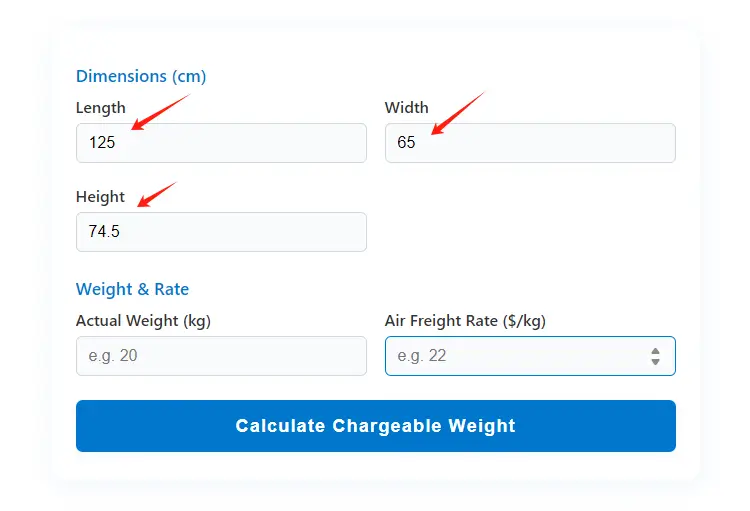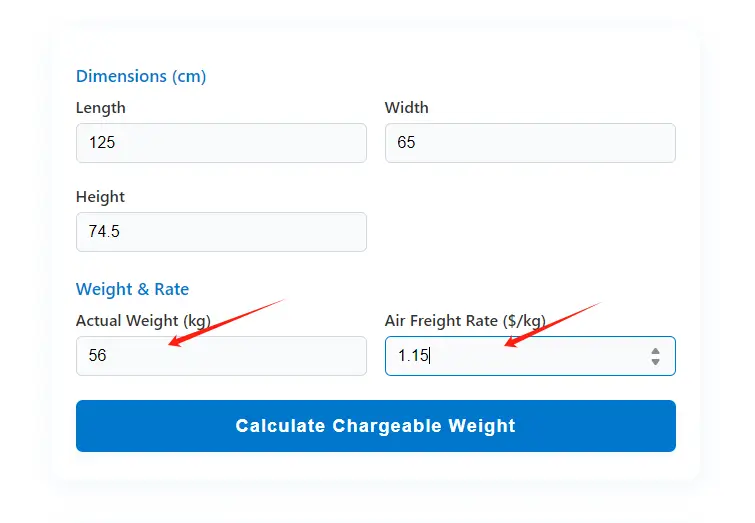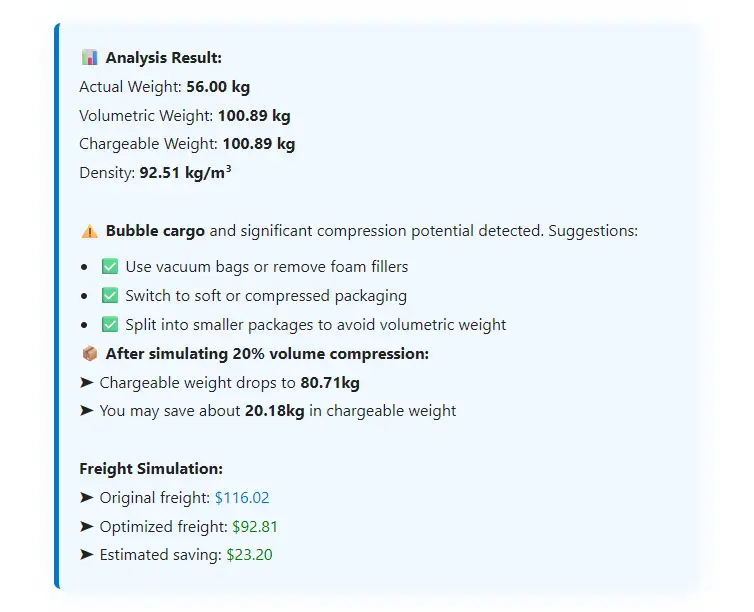How to Calculate Volumetric Weight for Air Freight Easily
How to Calculate Volumetric Weight for Air Freight Easily ? Understanding how to calculate volumetric weight is essential in international air freight.
Enter your own package data above and click "Calculate" to get real results.
📏 Formula: L × W × H ÷ 6000 (for air freight only)
📦 Detects low-density cargo
💡 Supports freight optimization by packaging
❌ Not suitable for ocean or land freight

Type in the length, width, and height of your package in centimeters. Precise measurements ensure accurate volumetric weight calculation.

Provide the actual weight of your package in kilograms and your air freight rate per kilogram to calculate shipping costs.

Click "Calculate" to see your volumetric weight, chargeable weight, and potential air freight cost savings instantly.
A Volumetric Weight Calculator is essential for understanding how different carriers charge shipping costs.
Various logistics providers apply different divisors when calculating dimensional or volumetric weight.
The most common are:
When using a shipping calculator, always confirm which divisor your carrier uses.
Our Volumetric Weight Calculator follows the IATA 6000 rule, ensuring precision for air freight calculations and reliable data across international shipments.
A Volumetric Weight Calculator is not just for airlines—it’s a practical tool for anyone managing logistics, eCommerce shipping, or warehouse planning.
Here are the most common use cases:
Using a freight cost calculator or Volumetric Weight Calculator helps businesses avoid overpaying for lightweight, bulky items and supports smarter packaging optimization strategies.
Many people miscalculate their shipping costs because they use the wrong formula or tool.
Below are common mistakes our Volumetric Weight Calculator helps you avoid:
By regularly checking your numbers with a Volumetric Weight Calculator, you’ll understand why your volumetric weight is higher than actual weight and how to reduce shipping charges effectively.
Our free Volumetric Weight Calculator provides real-time chargeable weight analysis and freight optimization.
Whether for air freight, international courier, or logistics planning, this Volumetric Weight Calculator is designed for accuracy, speed, and cost efficiency.
Start calculating today and reduce unnecessary freight expenses with confidence.
Your questions about volumetric weight, answered fast.
Volumetric weight, also called dimensional weight, reflects how much space a package occupies. Air carriers charge based on either the actual weight or the volumetric weight—whichever is higher. Our Volumetric Weight Calculator helps you determine this quickly and accurately.
Volumetric weight is calculated using the formula: Length × Width × Height (cm) ÷ 6000. Our Volumetric Weight Calculator automates this process to show whether your cargo is charged by weight or space.
Chargeable weight is the greater value between actual weight and volumetric weight. The Volumetric Weight Calculator compares both to identify the chargeable weight used to calculate air freight costs.
Bulky but lightweight cargo takes up valuable space. To ensure fair pricing, carriers use volumetric weight for billing. Our Volumetric Weight Calculator reveals whether your cargo will be charged by size instead of weight.
Reducing box size and using compact packing can significantly lower volumetric weight. The Volumetric Weight Calculator lets you test different package dimensions to see how small changes can cut shipping costs.
If your package has low density and the chargeable weight is much higher than the actual weight, repacking may help. Use our Volumetric Weight Calculator to detect this and find cost-saving opportunities.
Our Volumetric Weight Calculator is tailored for air freight and uses the standard divisor of 6000. It's suitable for most commercial shipments, but not ideal for sea or land freight which use different calculations.
The Volumetric Weight Calculator accepts dimensions in centimeters (cm) and weight in kilograms (kg). For other units, manual conversion is required before input.
Yes. The Volumetric Weight Calculator helps logistics professionals and shippers identify cost inefficiencies caused by excess volume, allowing smarter packaging and shipping decisions.
No. The Volumetric Weight Calculator does not give price quotes or compare carrier rates. It strictly calculates volumetric and chargeable weight to help you estimate potential cost differences based on weight vs volume.
Shipping tips and insights for smarter freight planning.
How to Calculate Volumetric Weight for Air Freight Easily ? Understanding how to calculate volumetric weight is essential in international air freight.
Ever looked at your air freight bill and thought, “Wait, why is it so expensive?” I think we're not clear whether airlines calculate shipping charges based on dimensional weight or actual weight.
Volumetric Weight vs Actual Weight in Air Freight Explained: Learn which one affects your shipping cost more—and how to avoid paying for empty space.
Understand IATA volumetric weight rules, why most airlines use the 6000 divisor, and how to use our calculator to avoid chargeable weight surprises.